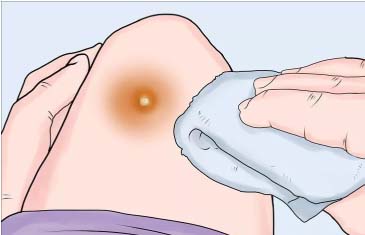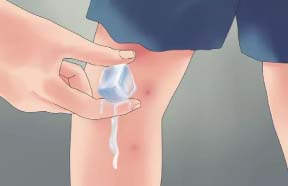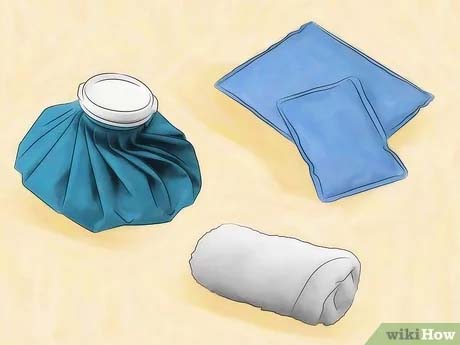I’m sure you’ve heard of the use of hot or cold compress to soothe common aches and pains. But the tricky part is knowing when to use hot or cold, and what medical conditions can be helped by this valuable treatment.
Below is a concise summary on what to do.
Hot compress preparations
You can make your own hot compress by buying a rubber water bag (around P100 only) and filling it with warm water. Do not use boiling water as this can melt through the rubber bag. Let the kettle cool for 10 minutes. A second option is to soak a towel in hot water, then rinse it a bit.
Another option is to buy a ready-made “plastic” preparation (available in drugstores) that you can soak in hot (or cold) water for some time. Afterwards, the bag will stay hot (or cold) for an hour or so. A cheaper but more dangerous option is fill a bottle with hot water and then wrap this up with a towel. The problem with this method is that the bottle can become very hot and burn the skin.

When to use hot compress
- Boil (pigsa in Filipino) is a reddish painful skin infection that contains pus inside. Placing a warm compress over the boil can hasten the softening and bursting of the boil. You can soak a cotton ball in hot water and place it over the boil for 15 minutes, three times a day. Next, soak the boil in Povidone iodine for around five to 10 minutes to kill the bacteria inside.
- Sty is a pimple-like eruption located in the eyelids. This frequently occurs in women and is caused by too much eyelash curling or make-up. Soak a cotton bud or cotton ball in warm water, and then place it over the sty for 10 minutes, two times a day.
- Arthritis and long-standing joint aches and pains. Apply warm compress over the painful area to relieve the pain and loosen the stiffened joint. This usually works well in cases of osteoarthritis, a type of arthritis caused by aging and overuse of the joint. Since osteoarthritis pain usually worsens during the cold months, you can wear pajama, long sleeves, gloves or socks to cover up the affected part.
- Muscle pain. When our muscles stiffen up due to overexertion, a warm compress can help loosen up stiff muscles. A hot shower also soothes and relaxes the muscles. Try it for back pain and body pains, too.
- Two days after a sprain. A sprain, such as an ankle sprain, is treated with a cold compress in the first two days. After the swelling subsides, you can use a warm compress to stimulate blood flow in the area by the third day. In this manner, the warm compress facilitates the removal of blood and debris in the injured area.
- Stomach pain. For those with stomach pain due to colic, gas or diarrhea, you can lessen the pain by placing a warm compress on the stomach area. The warm compress relaxes irritable and hyperactive bowels. Drinking warm water and chamomile tea also relaxes the stomach muscles.
- Hemorrhoids. The usual home remedy for hemorrhoids is a hot-sitz bath. The person sits on a container filled with warm water, and this helps reduce the swollen blood vessels of the hemorrhoids. You can buy a hot-sitz bath container in any drugstore. (This container is conveniently hooked inside the toilet bowl for you to sit over it.)

Cold compress preparations
To prepare a cold compress, simply get some ice and place it in a plastic bag or a water bag. You can also soak a towel in ice-cold water. Moreover, there are ready-made plastic preparations that you can cool inside the refrigerator. If you want a cheaper option, get some smooth stones and cool it in the refrigerator.
When to use cold compress
- Generally used for acute conditions. If a part of your body feels hot, such as the knees after a long walk, then a cold compress can help ease the inflammation. A headache or a fever can also be treated by a cool towel on the forehead.
- Any insect bites. The first aid for insect bites is to immediately put ice on the area. This will help reduce the swelling and lessen the itchiness.
- Right after getting a sprain, swelling or bruising. If you’ve had an injury that caused some bruising or bleeding, you should ice the area immediately. Anything cold will stop the bleeding and hasten blood clotting. Continue placing a cold compress on the area for the first two days. By the third day, you can slowly shift to a warm compress, this time, to increase blood flow in the area.
- Any bleeding wound, including gum and nose bleeding. Use a cold compress to help stop the bleeding. You may also apply gentle pressure on the area (for 10 to 15 minutes) until the bleeding stops. If you have nosebleed, press over the bridge of the nose and apply cold compress on the area.
- For eye bags. As a beauty regimen, put ice (or a cold cucumber) underneath the eyes to reduce morning eye bags. You can wash your face with cold water, too.
A few precautions
For those people with diabetes, stroke and numbness, be careful in using hot and cold treatments. If you have a problem with detecting pain (due to nerve injury, for example), then you can accidentally burn yourself without knowing it. The elderly should likewise exercise caution in using this treatment.
Finally, learn to make use of this simple and effective home remedy. For more serious cases, consult your doctor. Images from www.wikihow.com. — First published in Tulay Fortnightly, Chinese-Filipino Digest 29, no. 13 (December 06-19, 2016): 11.





